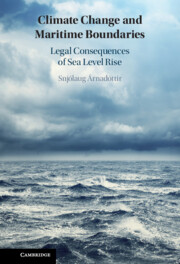26 results
4 - Migration and Displacement Risks Associated with Mean Sea Level Rise
-
- Book:
- Migration and Displacement in a Changing Climate
- Published online:
- 10 April 2025
- Print publication:
- 17 April 2025, pp 131-161
-
- Chapter
- Export citation

Migration and Displacement in a Changing Climate
-
- Published online:
- 10 April 2025
- Print publication:
- 17 April 2025

Governing Sea Level Rise in a Polycentric System
- Easier Said than Done
-
- Published online:
- 30 March 2024
- Print publication:
- 25 April 2024
-
- Element
- Export citation
Climate change and human security in coastal regions
-
- Journal:
- Cambridge Prisms: Coastal Futures / Volume 2 / 2024
- Published online by Cambridge University Press:
- 12 February 2024, e5
-
- Article
-
- You have access
- Open access
- HTML
- Export citation
2 - Water (Too Much)
-
- Book:
- Radical Adaptation
- Published online:
- 04 January 2024
- Print publication:
- 18 January 2024, pp 52-80
-
- Chapter
- Export citation
Building Flood Resilience Among Older Adults Living in Miami-Dade County, Florida
-
- Journal:
- Disaster Medicine and Public Health Preparedness / Volume 17 / 2023
- Published online by Cambridge University Press:
- 31 July 2023, e465
-
- Article
-
- You have access
- Open access
- HTML
- Export citation
9 - Local Resilience, Land Use Law, and Disaster Planning
- from Part III - Law’s Role in Promoting Hazard Mitigation: Intergovernmental, International, National, and Local Approaches
-
-
- Book:
- The Cambridge Handbook of Disaster Law and Policy
- Published online:
- 27 October 2022
- Print publication:
- 29 September 2022, pp 151-180
-
- Chapter
- Export citation
2 - The Risks of Climate Change, or Why Carbon Budgets Need to Be Binding
-
- Book:
- Alligators in the Arctic and How to Avoid Them
- Published online:
- 14 July 2022
- Print publication:
- 28 July 2022, pp 37-52
-
- Chapter
- Export citation
Climate Change and International Legal Personality: “Climate Deterritorialized Nations” as Emerging Subjects of International Law?
-
- Journal:
- Canadian Yearbook of International Law / Annuaire canadien de droit international / Volume 59 / November 2022
- Published online by Cambridge University Press:
- 22 July 2022, pp. 1-35
- Print publication:
- November 2022
-
- Article
- Export citation
Provisional boundaries and alternative solutions to maritime delimitation
-
- Journal:
- Leiden Journal of International Law / Volume 35 / Issue 2 / June 2022
- Published online by Cambridge University Press:
- 11 February 2022, pp. 397-406
-
- Article
- Export citation
Stability of maritime boundaries and the challenge of geographical change: A reply to Snjólaug Árnadóttir
-
- Journal:
- Leiden Journal of International Law / Volume 35 / Issue 2 / June 2022
- Published online by Cambridge University Press:
- 03 February 2022, pp. 379-395
-
- Article
- Export citation
1 - Law of the Sea and the Changing Marine Environment
-
- Book:
- Climate Change and Maritime Boundaries
- Published online:
- 02 December 2021
- Print publication:
- 09 December 2021, pp 3-12
-
- Chapter
- Export citation

Climate Change and Maritime Boundaries
- Legal Consequences of Sea Level Rise
-
- Published online:
- 02 December 2021
- Print publication:
- 09 December 2021
4 - Do-It-Yourself Climate Change Science
-
- Book:
- Drought, Flood, Fire
- Published online:
- 01 June 2021
- Print publication:
- 27 May 2021, pp 59-91
-
- Chapter
- Export citation
1 - State of Salt Marshes
-
-
- Book:
- Salt Marshes
- Published online:
- 19 June 2021
- Print publication:
- 22 April 2021, pp 1-6
-
- Chapter
- Export citation
13 - Climatic Impacts on Salt Marsh Vegetation
- from Part III - Marsh Response to Stress
-
-
- Book:
- Salt Marshes
- Published online:
- 19 June 2021
- Print publication:
- 22 April 2021, pp 337-366
-
- Chapter
- Export citation
Vulnerability of megapodes (Megapodiidae, Aves) to climate change and related threats
-
- Journal:
- Environmental Conservation / Volume 45 / Issue 4 / December 2018
- Published online by Cambridge University Press:
- 23 April 2018, pp. 396-406
-
- Article
- Export citation
Coastal plain stratigraphy records tectonic, environmental, and human habitability changes related to sea-level drawdown, ‘Upolu, Sāmoa
-
- Journal:
- Quaternary Research / Volume 87 / Issue 2 / March 2017
- Published online by Cambridge University Press:
- 27 February 2017, pp. 246-257
-
- Article
- Export citation
Sea level, paleogeography, and archeology on California's Northern Channel islands
-
- Journal:
- Quaternary Research / Volume 83 / Issue 2 / March 2015
- Published online by Cambridge University Press:
- 20 January 2017, pp. 263-272
-
- Article
- Export citation
Embedding (some) benefit-cost concepts into decision support processes with deep uncertainty
-
- Journal:
- Journal of Benefit-Cost Analysis / Volume 5 / Issue 3 / December 2014
- Published online by Cambridge University Press:
- 17 April 2015, pp. 487-514
-
- Article
-
- You have access
- Export citation

